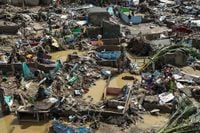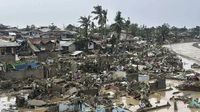Typhoon Kalmaegi, locally known as Tino, has left a devastating mark on the Philippines, with the latest reports confirming at least 116 fatalities and dozens more missing as of November 5, 2025. The storm, which struck the archipelago on November 4, has been described by local officials and residents as the deadliest to hit the nation in a year, eclipsing the destruction wrought by previous typhoons and compounding the woes of communities still reeling from other recent disasters.
Central to the tragedy is Cebu province, where the majority of deaths have been recorded. According to the Philippines Star and BBC, at least 49 of the victims lost their lives in Cebu alone, as flash floods and landslides swept through densely populated areas. The situation was made even more precarious by the province’s fragile infrastructure, still recovering from a magnitude 6.9 earthquake that struck in late September 2025. Governor Pamela Baricuatro, who declared a state of calamity on November 4, expressed the sense of desperation gripping her province. “We were expecting the winds to be the dangerous part, but ... the water is what’s truly putting our people at risk. The floodwaters are just devastating,” she posted on Facebook.
The scale of displacement is staggering. More than 500,000 people have been forced from their homes, with thousands still sheltering in temporary evacuation centers as of November 5, reports UPI and The Watchers. In Mandaue City, resident Jen-al Moira Servas described the aftermath: “Right now, the rain has completely stopped and the sun is out, but our houses are still filled with mud, and everything inside is in shambles. We don’t even know where to start cleaning. I can’t even look at it without crying,” she told the BBC.
Typhoon Kalmaegi made landfall late on November 4, unleashing torrential rains that dumped a month’s worth of precipitation in just 24 hours over Cebu City—183 mm (7.2 inches), far exceeding the monthly average of 131 mm (5.2 inches), according to state weather specialist Charmagne Varilla (AFP). The resulting deluge overwhelmed rivers and storm drains, submerging entire neighborhoods and leaving cars and shipping containers tossed across streets. Volunteer rescuer Carlos Jose Lañas, 19, recounted to the BBC, “This is the worst flood I’ve ever experienced. Almost all the rivers here in Cebu overflowed. Even emergency responders did not expect this kind of scenario. The rescue operation was too overwhelming for the emergency responders around Cebu because there were a lot of people asking for help.”
Emergency operations have been hampered by both the scale of the disaster and the destruction of critical infrastructure. Six military personnel died when a Philippine Air Force helicopter crashed in Agusan del Sur, Mindanao, while delivering aid to isolated communities. The military has launched an investigation into the crash, which occurred amid ongoing humanitarian missions. Power outages, blocked roads, and damaged ports and bridges left several municipalities cut off for hours, delaying the arrival of food, water, and medical supplies. OCD Deputy Administrator Rafaelito Alejandro IV told local radio, “All the floods have subsided. Our challenge now is the clearing of this debris that is blocking our roads.”
The typhoon’s impact was especially severe in urban centers such as Cebu City and Talisay, where floodwaters rose rapidly overnight, trapping residents on rooftops and forcing dramatic rescues. Local authorities in Talisay City reported dozens of homes destroyed and streets littered with overturned vehicles and debris. Many victims drowned or were trapped in collapsed homes as the waters surged with little warning. The Office of Civil Defense (OCD) confirmed that most casualties resulted from flash floods rather than wind damage.
Government agencies and volunteers have responded with large-scale rescue and relief operations. The Philippine Coast Guard deployed four Deployable Response Groups to evacuate residents stranded by the floods, while local governments mobilized emergency resources under the state of calamity order. President Ferdinand Marcos Jr. has directed cabinet members to monitor the situation closely, emphasizing that “the welfare of the people” is the administration’s top priority, according to Presidential Communications Undersecretary Claire Castro.
By November 5, floodwaters had mostly receded in Cebu and surrounding areas, but the recovery task ahead remains daunting. Thousands of families are still in temporary shelters, and many communities are without electricity or clean water. Efforts are underway to clear debris, restore power and telecommunications, and reopen access to isolated regions. Relief agencies are racing against time to deliver supplies before another tropical cyclone, which the weather bureau Pagasa warns could reach super typhoon status by November 8, threatens to bring new "life-threatening stormy conditions" to Luzon.
Typhoon Kalmaegi is the 20th storm to strike the Philippines in 2025, a testament to the country’s vulnerability to extreme weather. Each year, the nation is battered by around 20 typhoons and storms, with millions living in disaster-prone regions where poverty and inadequate infrastructure amplify the risks. The latest disaster has also reignited public scrutiny of government flood-control projects. Governor Baricuatro voiced frustration over the issue, writing, “26 billion (pesos) of flood control funds for Cebu yet we are flooded to the max.” Allegations of corruption and mismanagement in public works have fueled outrage as citizens demand accountability and effective protection from future disasters.
Weather agencies tracked Kalmaegi as it moved west-northwest over the South China Sea after lashing the Visayas islands, with maximum sustained winds of 130 km/h (81 mph) and gusts up to 180 km/h (112 mph), according to PAGASA. The storm was forecast to exit the Philippine Area of Responsibility late on November 5 or early November 6 and make landfall in central Vietnam by November 7, bringing further concerns for countries already grappling with severe flooding.
In a year already marked by tragedy, Typhoon Kalmaegi has exposed the persistent vulnerabilities of the Philippines. While floodwaters have receded, the scars left behind—both physical and emotional—will take far longer to heal. As recovery efforts continue and another storm looms on the horizon, the resilience and solidarity of affected communities will once again be put to the test.






